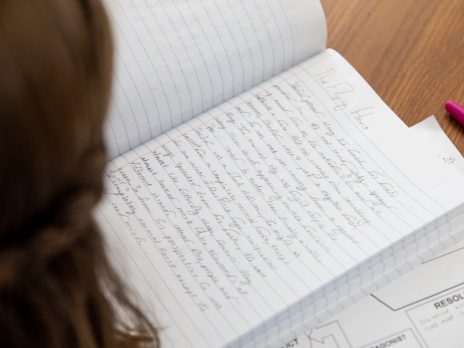Strategies for incorporating writing assignments
Research conducted by interns in the Lumberjack Writing Center shows that students are extrinsically motivated.
We learned that students focus on the course grade, and will work hard if they know that the course grade will drop if they don’t perform well.

Writing that accounts for 5-20% of the overall course grade tells students that failing the writing assignment(s) still allows for a low “B” in the course.
When writing assignments are worth 25% of the overall grade, students often put in more time into their writing because an overall course grade of a “C” is deemed unsatisfactory.
Suggested language to emphasize writing in your course description Accordion Closed
Please note: The language below is suggested language. You are welcome to copy and paste, or to synthesize, revise, and to edit.

In our field of [insert discipline] the skill of writing is expected from junior hires and is necessary for advancement and promotion. Writing requires revision and self-editing skills that are best learned with an outside reader who provides feedback on:
- Your ideas
- Logic of your organization
- Structure of your paragraphs
- Level of detail provided
- Topic sentences that organize your paragraphs
- Integration of research into your document
In this course, writing is a form of communication that shows what you have learned. All writing you submit to me is considered to be your final draft. No first drafts are acceptable.
Submitting only well-crafted and revised writing shows that you understand that all writing matters — from an email to a lengthy document.
You are encouraged to work with an outside reader (the University Writing Commons has Writing Assistants available for an appointment) to support your best representation of your learning.
If you are on your own, review your writing with the assignment prompt and rubric as reference checks. Focus on your introductory paragraph, topic sentences, and the integration of evidence that you provide.
Suggested language to emphasize writing in a presentation Accordion Closed
Please note: The language below is suggested language. You are welcome to copy and paste, or to synthesize, revise, and to edit.

Slides are often equated with a class lecture; students are quick to take notes when you provide slides that emphasize how important writing is the the class.
The following suggested statements are meant to assist you with emphasizing the importance of writing in your major.
- Email, memos, notes, and meeting synthesis are written documents in this course and field. Practice and submit only final drafts.
- I expect all written documents to be revised and edited.
- My role is to read your documents as a client would. Your role is to submit your best written final drafts.
- I will use materials from [your disciplinary database and URLs]. You should make sure to review the [IWP Resources].
- The grading rubric is my guide for grading. The rubric is your guide for writing.
- Grade yourself! For each submitted document, grade yourself using the rubric – explain your grade in one paragraph.
- The more that you write to learn, the more details you will understand and better articulate.
- As you practice learning to write, you will become more confident and capable to follow through.
- You will write to learn and learn to write by continually practicing and working with an outside reader on all stages of writing.
- In our field, you will be expected to know or figure out who your audience is, what the purpose of the document is, and to quickly assess what you will need to complete the document.
- When you are away from the University, there is no syllabi with opportunities to revise and resubmit – practice these skills now. Always submit edited and revised writing.
Asking students to write instead of talking through or present their ideas orally, can cultivate new practices to:
- Assess student learning through in-class writing (writing to learn)
- Expose students to disciplinary communicative practices (learning to write)
Writing to Learn and Learning to Write assignments provide space for students to engage with complex ideas and new course materials and opportunities to practice written communication.
Writing to learn Accordion Open
These assignments are low-stakes and not graded. Additionally, it is a good way to see what the students understood from the course materials. We have shared an example of a low-stakes writing assignments below.
- Journals: A notebook is an excellent way for the student-writer to practice articulating new ideas and research findings in a low-stakes medium. This could include time for in-class writing or it can be incorporated into the at-home writing. A required notebook that is checked for content organization implies that the final written document is important and will require attention before submission.
- Field-note journal: NAU’s geologist Lisa Skinner teaches her students to use field notes as reference tools that are organized reminders of details that are sometimes forgotten after the time of data collection, research, and reflection.
- Research journal: Similar to the field-note journal, students use a research journal to manage their findings, their evolving research questions, and their questions for research librarians and for their professors.
- Visual media journal: Keeping a journal for tables, charts, photographs, or sketches is one way for a student to organize visuals important in their final paper or presentation. These journals provide insight into the student’s learning and provide an easy way for faculty consultation-feedback.
Learning to write Accordion Closed
These assignments are high-stakes and are often graded. These assignments function to immerse the student in the disciplinary writing norms and require multiple drafts. We have shared a few examples of high-stakes writing assignments below.
- Progress reports: Building in space for students to check-in about their final paper or project, fosters new opportunities for students to improve or change their plan. Additionally, progress reports push students to begin the assignment early, so they can finish the progress report and final project on time.
- Online blogs: Online blogs provide a new opportunity for students to write to a public audience. While some students might have experiences writing non-professional blogs, it is important to remind them that these blogs can serve as a public platform for professional purposes.
- Proposals: Creating space for Students to write a proposal and outline the purpose of their final assignment, cultivates opportunities for early data collection and time to overcome constraints.
- Artist profiles: When students exhibit their work publicly, it is especially important to include a well-written artist profile with their work. Consider collaborating with a colleague whose students can practice providing feedback during a drafting-stage.
- Email: Email communication is an excellent way to provide a practical professional document for writing practice.
- Email to a professor: An email to you is a good alternative to the traditional cover letter. Writing an email is great practice for careful revision and line-by-line editing, especially if you require students to be professional when communicating with you on email.
- Email to a public audience: Writing to an outside audience has a higher stake since students not only present themselves but also the university and your course. Students have to revise before submitting because they identify as a professional.
Additional resources Accordion Closed
- Informal writing assignments (Writing to learn): This resources from the University of Wisconsin encourages teachers to use writing to learn assignments to help students build their understanding of the subject.
- What students write: This Inside Higher Education article from 2014 argues that better writing assignments will lead to better student writing.
- Visit our blog: We have worked with student groups on campus and have provided tailored feedback to organizations and groups that want to integrate writing.
- Explore: Our online assignment suggestions and templates.




